Reef environments
Reef environments

Corals, the main framework builders of modern reefs, thrive under a particular set of environmental conditions, most notably in clear, warm sunlit waters. Perhaps surprisingly, many corals can also grow in cooler, and/or less well illuminated waters, as explained here and elsewhere (see Mesophotic environments), although most prefer the former conditions.
Charles Darwin, in his 1842 opus (Darwin, 1842), produced the first global map of coral reefs, clearly showing their tropical distribution. Darwin's map included most of the world's major reef systems, and he also famously identified the mechanism by which the atolls formed, a subject of major scientific controversy of the day.
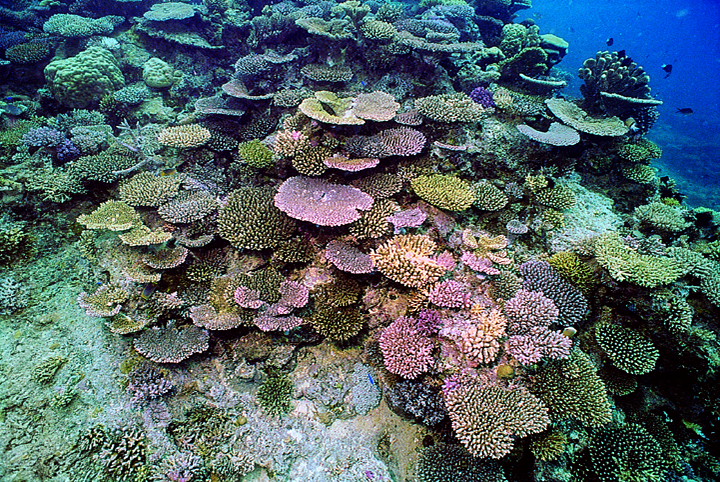
Clear water back reef slope leading down into the lagoon. Fiji Photograph: Neville Coleman Figure 1.
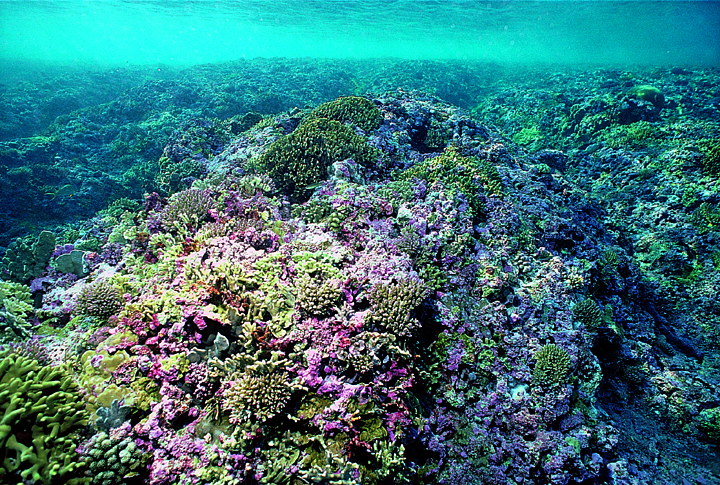
Upper reef slope exposed to wave action. Scott Reef, Western Australia Photograph: Charlie Veron Figure 2.
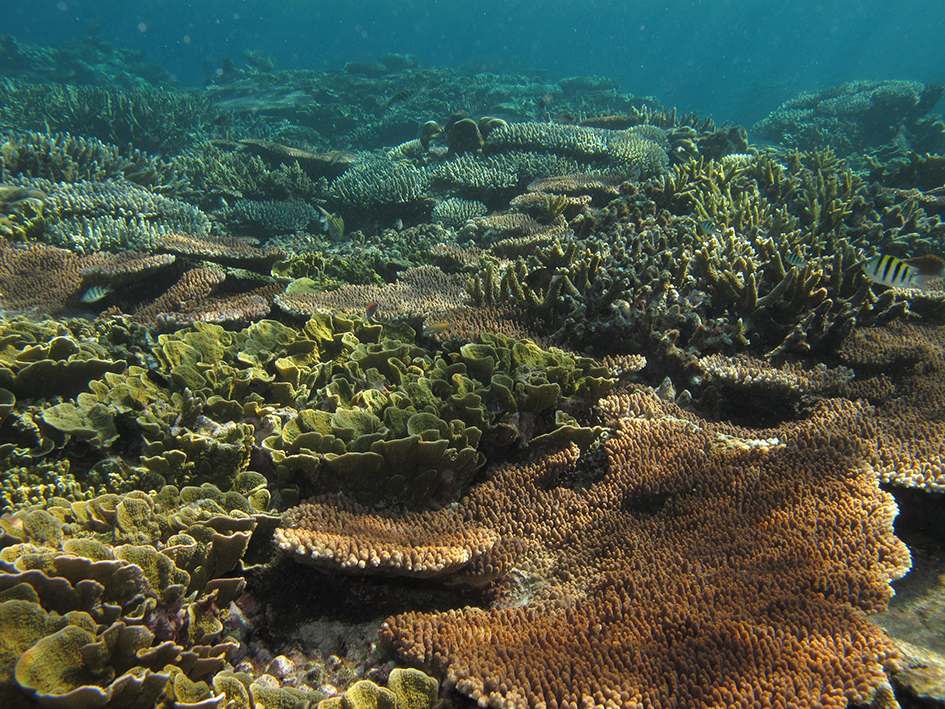
Shallow sunlit community dominated by Acropora. Anambas Islands, Indonesia Photograph: Lyndon DeVantier Figure 3.
Today the conditions under which reefs flourish are well known, almost axiomatic, as seen in thousands of photos and videos extolling the joys of a tropical coral reef holiday. Less well understood, however, is that particular coral species, populations within each species, and colonies within each population exhibit different tolerances to environmental conditions, and changes therein. These inter- and intra-specific differences in environmental tolerances are crucial to predicting the future of corals and the reefs they build under rapid global change. Here the roles of the main environmental parameters are briefly described.

Light
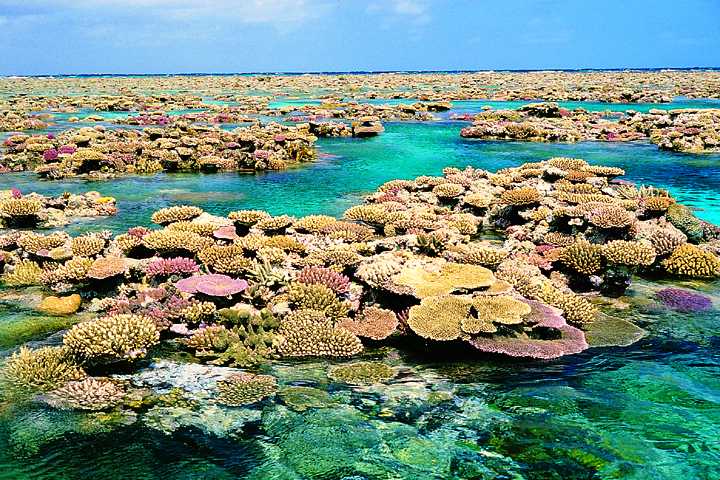
Reef flat exposed to intense light at low tide. Great Barrier Reef, Australia. Photograph: Roger Steene Figure 4.
Like trees, reef-building corals depend on photosynthesis: they use the resources of solar energy to produce food. However, about half of all Scleractinia do not have symbiotic algae (azooxanthellate species). Some azooxanthellate corals live on coral reefs, especially under overhangs or in caves, but with the exception of a few species that have both symbiotic and non-symbiotic colonies, all zooxanthellate corals need light, and it is only these corals that build reefs. As a result, reefs are restricted to shallow sunlit waters. Azooxanthellate corals are not limited by light or by temperature, nor are they confined to shallow sunlit water; they live in the vast expanse of the ocean depths where there is less competition for space. These taxa live without food from photosynthesis and cannot build reefs: food can only come from the chance capture of passing plankton or from detritus and dissolved organic matter.
Corals growing in very shallow water such as reef flats have sunscreens (chemical agents in their tissues) to reduce the amount of light reaching their zooxanthellae, because if this is not controlled the zooxanthellae can produce toxic amounts of oxygen, the principal cause of mass bleaching.
The latitudinal limits of reef development are contingent on light, along with temperature, particularly during winter. For reefs to grow, accretion must be greater than erosion, via physical (eg. waves), chemical (rainwater dissolution) and biological processes. Rates of bioerosion, from excavation by urchins, boring sponges, worms, fishes and a diverse array of other organisms, can exceed accretion in many reef areas, particularly under marginal environmental conditions. Another important factor that affects coral growth, accretion and reef development is competition for space by macro-algae.

Water depth and turbidity
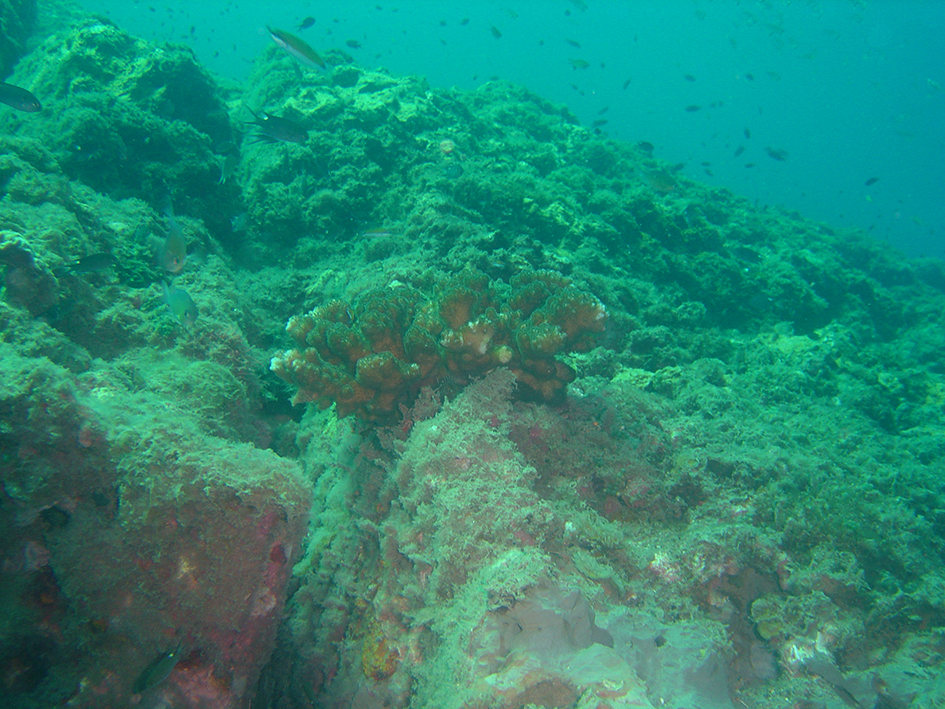
Turbid environment showing corals on a sediment covered slope. Brunei. Photograph: Lyndon DeVantier. Figure 5.
Any factors which alter light in the marine environment will have a significant effect on calcification rates and reef development. Even so, the depth to which zooxanthellate corals can grow has been greatly understated in most of the older literature. Under optimal conditions corals can occur below depths accessible to most scuba divers (ie. below 50-60m depth). In recent years, corals occurring in deeper waters of low illumination, the 'mesophotic zone', have become a significant focus of research. This is partly attributable to hopes that such mesophotic habitats may provide refugia for corals from impacts associated with global warming - the 'deep reef hypothesis'. Nevertheless, only a few zooxanthellate corals live below 100 metres, even where the water is very clear and the substrate does not slope so steeply that it is shaded. Leptoseris commonly forms extensive beds to at least 160 metres in the Red Sea and Hawaii and there are several records of moderately diverse coral communities at depths of over 100 metres elsewhere. For further information about the mesophotic zone and its corals see Mesophotic environments.
Turbidity has a dominant role to play in controlling light levels in all except clear-water habitats. Where the water is not very clear, as is the case with most reefs near major land masses, coral diversity decreases sharply below about 50 metres. Where the water is particularly muddy, such as occurs along many coastal zones, the depth limit for any coral can be as little as 5 metres. Turbidity, especially that caused by fine clay particles which are easily re-suspended by wave action, has other effects on corals besides reducing light. These effects, which include choking and smothering, are considered below.

Temperature
Temperature sets limits on the latitudinal spread of corals throughout the world. A different temperature, acting in concert with light, constrains the spread of reefs. The difference between these two — constraints on corals and on reefs — has created havoc in palaeoclimatic reconstructions of past reef environments as well as studies of reef growth because it is so widely misinterpreted.
Low temperature limits for reef and coral growth
It has been known for decades that reefs do not form where the ocean temperature regularly goes below 18°C for intervals of weeks to months. Reef geologists concerned with the history of reefs refer to this well-established fact, yet in so-doing they often assume that lower temperatures kill corals. This is seldom the case.
Reef-building allows entire ecosystems to exist, a process that can only happen if accretion exceeds erosion and, crucially, the growth of macro-algae is held in check. This requires a great deal of uninterrupted energy, which is why reef-building corals are dependent on symbiotic algae. This symbiosis requires exposure to sunlight, which is why reef building corals are restricted to shallow water. Around 18°C corals are able to produce calcium carbonate fast enough to fulfil their guild role as producers of building materials. This is achieved by creating three dimensional habitats where herbivores, especially fish, can control algae for them. At lower temperatures algae usually outgrow corals; however the corals themselves are not killed by temperatures lower than 18°C. This is best seen along the Ryukyu Islands of Japan where the southern islands have extensive reefs yet further north the sea temperature progressively decreases until it reaches the critical 18°C point. It is here that reef development fails. The corals, however, do not: nearly half of all coral species regularly tolerate prolonged exposure to 14°C. A few tolerate 12°C although seldom less (azooxanthellate corals excepted). One example of a species with broad temperature tolerance is the widespread Plesiastrea versipora. It occurs in both tropical and temperate waters of the Indo-west Pacific, the latter most notably around southern Australia. Additionally there are a few reef-building species that are cool-water specialists, including Symphyllia wilsoni and Coscinaraea mcneilli.
It was once believed that corals in cold high latitude regions had an ephemeral existence, neither reproducing nor growing like their tropical counterparts. However, this is not so. As far as is known, corals reproduce normally in high latitudes. There are some taxonomic variations, the most important being that massive colonies of Porites seldom do well in temperate waters. Neither do some other taxa, notably free-living disc-shaped ‘mushroom’ corals (e.g. Fungia spp.). It is not known why but it presumably has a physiological basis, either in the larvae or adult.
High temperature limits for reef and coral growth
Low and high temperature limits do not mirror each other. This is because corals are highly dependent on upper temperature limits. Nevertheless, high temperature per se has little direct negative effect on corals. The warmer the water the faster most metabolic processes become and the faster calcification could become if it were not for the temperature effect on zooxanthellae. Faster metabolic rates for zooxanthellae mean faster photosynthesis which, in turn can result in oxygen being produced at rates where it becomes toxic. Corals are forced to expel their increasingly poisonous zooxanthellae and 'bleach', a response to temperature and light acting in concert (see Algal symbiosis and mass bleaching).
When it comes to high temperature limits, those of coral growth and reef growth are more or less the same for they have the same upper limit, linked to the upper limit of the ocean in which they occur. One caveat is that short pulses of abnormally high or ‘elevated’ sea temperature can disrupt coral growth through initiation of bleaching, yet reef growth may continue through the process of cementation. Coral growth typically may be restored through recovery of survivors of the high temperature event and subsequent recruitment; when ambient sea conditions return to the normal range.
General points about the effects of high temperature on coral and reefs are:
- Higher temperatures lead to higher coral growth rates up to the point where oxygen toxicity becomes an issue. This is best observed by measurement, for these higher rates are normally associated with weaker skeletons, as if the coral's tissue outgrows its ability to form its own skeleton.
- There seems to be no good correlation between temperature and the rate of reef growth. Perhaps the higher rate of production of skeletal calcium carbonate is offset by the production of weaker skeletons which are more quickly eroded; however, there are too many facets to this issue to give it unambiguous support.
- Although the Coral Triangle — the global centre of biodiversity extending from the Philippines to the Solomon Islands — has an equatorial position it is unlikely that high temperature alone leads to this region's high diversity. Such exceptional diversity, including some three-quarters of all reef building corals, is not seen in other tropical regions and there are other reasons for it in the Coral Triangle including habitat diversity and the close interlinking of surface currents.

Substrate, turbulence and mechanical effects of turbidity
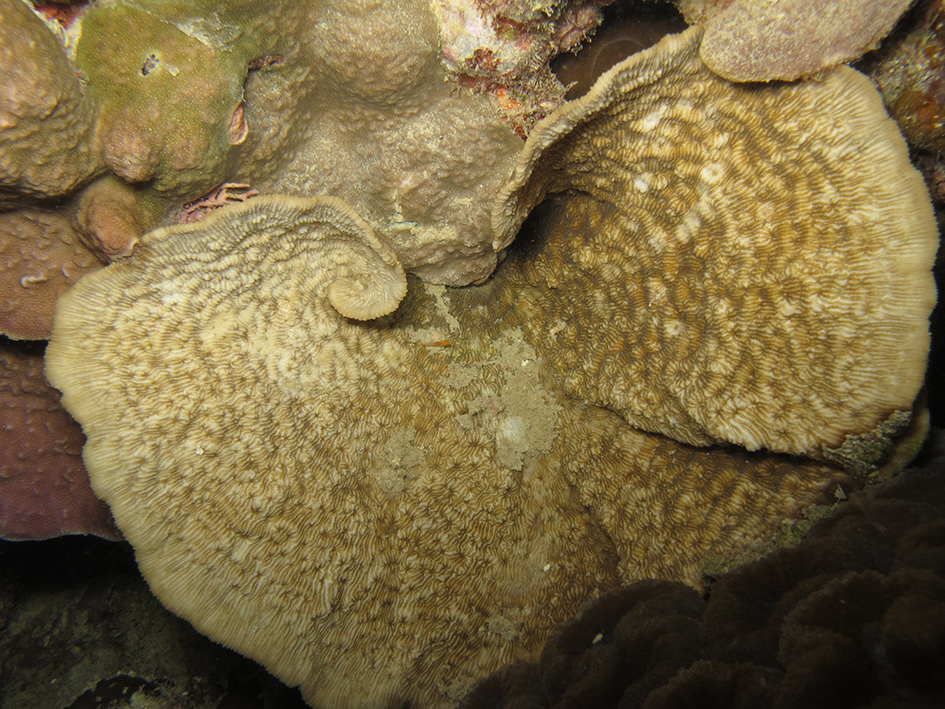
Turbid environment showing sediment accumulating on the tissues of Psammocora explanulata requiring ongoing energy for removal. Anambas Islands, Indonesia. Photograph: Lyndon DeVantier. Figure 6.
There is a strong ecological gradient across many continental reef systems, most well known on Australia's Great Barrier Reef and Indonesia's Spermonde Archipelago, ranging from a muddy inshore coastal zone to a clear-water offshore reef zone. A similar gradient is likely to occur in most other regions where reefs are situated from nearshore to offshore. Substrate type and water clarity are always closely linked, especially when depth and turbulence are factored in. White calcareous sand, although typically coarse-grained, is light and therefore readily moved around by wave action, in which case it is capable of burying corals if suspended in sufficient quantity. However, it is clay from rivers that most adversely affects corals, for not only does it attenuate light, it requires cleaning away — which corals do by using cilia on their tentacles as well as by several other methods — a costly activity in terms of metabolic energy.
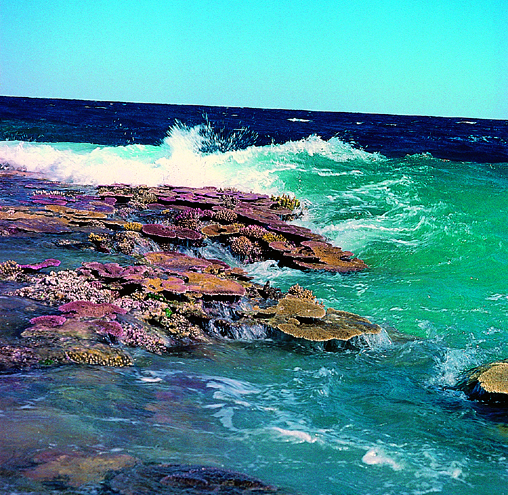
Highly turbulent environment of the reef crest where corals develop dense skeletons to withstand intense wave action. Great Barrier Reef, Australia. Photograph: Charlie Veron. Figure 7.
Substrate is also of paramount importance to settling larvae, for these will not settle on sand of any sort, or on substrates that are coated with bacterial slime as commonly develops on reefs that have been degraded. Corals prefer solid substrata coated with particular species of crustose coralline algae, and typically settle in crevices on the reef matrix rather than on open surfaces where grazing fishes and predators have easier access. A few coral species, including Acropora russelli, do, however, have larvae that can settle on small pieces of rubble or shell on otherwise sandy substrate, and in the case of Acropora torihalimeda, even atop beds of the calcareous green algae Halimeda.
One major effect of turbulence on coral skeleton formation is that wave action produces dense skeletons. The corals on a high-energy reef front typically have extremely hard, dense skeletons, whereas those in a protected lagoon have light, brittle skeletons. This is partly because of the differences in species that occupy these habitats, yet even within the same species the effect is pronounced. Another cause of such differences in skeletal density is nutrient enrichment, and complex interactions on coral growth can result from the synergistic or antagonistic combination of these various factors in reef environments, as described below.

Water quality
The term 'water quality' is commonly used in connection with the health of the marine environment. Water quality that is good for particular coral reefs or coral communities is assumed to have tolerable levels of sediments and nutrients and environmental contaminants. The term is therefore used in the context of the health of reefs and possible degradations of that health by human activities. Otherwise, it is used as a descriptor of 'normal' environmental conditions. In this context, normal does not mean permanent, for there are no baselines for coral reefs, only intervals of time when the environment appears not to change in a substantial way. This has most recently been the case during the past 6,000 years of the Holocene Epoch, once sea level stabilized following the post-glacial transgression, and prior to the recent and continuing major changes resulting from the industrial revolution and human conquest of Earth since the 1700's. This new epoch has recently been named the Anthropocene, in recognition of our collective impact in driving the sixth mass extinction and our future 'signature' in the fossil record.
As introduced above, corals growing close to coasts may be exposed, chronically or episodically, to runoff from streams or rivers. In addition to lowering salinity of the receiving waters, particularly surface waters, runoff can also transport nutrients, pesticides and particulate matter derived from land-use in the catchments.
Salinity is an aspect of water quality that has not been adequately studied. Corals appear to be sufficiently tolerant of high salinity,, as occurs for example in Red Sea and Arabian-Persian Gulf, that lethal levels seldom, if ever, occur naturally. The opposite commonly applies to low salinities for these play a large role in creating areas where there is little or no coral or reef growth. Brief excursions of low salinity, as can occur in surface coastal waters following flooding, typically induces bleaching of affected corals. Indeed, it was such an instance that first alerted Tom Goreau Snr to the bleaching phenomenon back in the 1960's. Corals commonly grow in and around mangrove areas, either by being tolerant of low salinities or because these places have no freshwater intake other than directly from rain which remains on the ocean surface until removed by wind or tide.
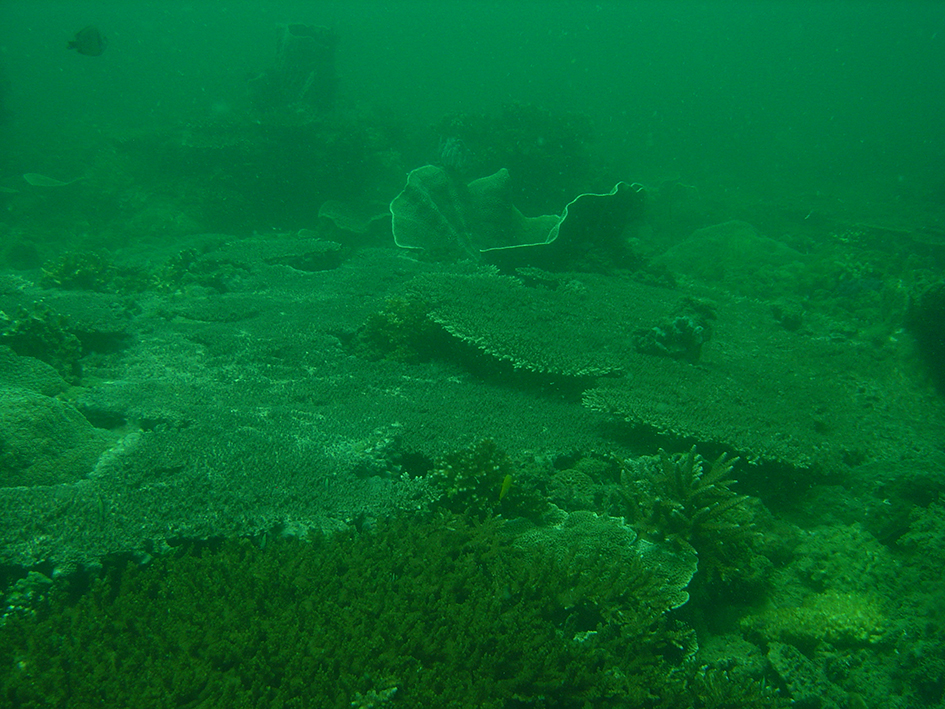
Nutrient enriched waters can cause phytoplankton blooms, giving waters a greenish hue and reducing illumination. Brunei. Photograph: Lyndon DeVantier. Figure 8.
Nutrients and pesticides have complex direct and indirect effects on corals, as indeed on other species. At certain levels, nutrients like Nitrogen and Phosphate can stimulate coral growth, often at the expense of skeletal density. At higher levels, nutrients can reduce the tolerance of corals to heat and light stress, and hence increase susceptibility to bleaching. Nutrients also stimulate growth of phytoplankton which can cause a reduction in illumination, or of macro-algae which can outcompete corals, shading and ultimately overgrowing them. Effects of pesticides are less well known, but experimental studies have shown that certain fungicides and insecticides can disrupt biological processes, including gametogenesis, larval development and settlement.
There are other environmental controls on reef-building hidden in water chemistry that may not overtly limit reef distribution today but which may have been important in the geological past and are destined to become so in future. Oceans are normally so well buffered that chemical changes are infinitesimally slow, providing plenty of time for organisms to evolve adaptations to any alteration. However, sometimes the rate of change exceeds physical or biological thresholds and cannot be tolerated by any except the most specialised organisms. This can happen when large tracts of ocean become anoxic, hydrogen sulphide concentrations become toxic, pH alters beyond tolerable limits for calcification, or other contaminants make the water uninhabitable. At present, several of these processes have been initiated by human activities, of which changes in pH are of most concern for corals and reefs.

Acidification
Changes in ocean chemistry resulting from the combustion of fossil fuels are rapidly lowering ocean pH, with significant negative effects predicted for coral growth and reef-building. As with all other environmental parameters, different coral species, populations and colonies within populations have different tolerance levels to declining ocean alkalinity, in part related to their capacity to regulate their internal pH during the calcification process, a metabolic cost to each organism. The likely longer-term (decades to centuries) impact is increasing 'marginality' of reef systems to support coral growth with concomitant declines in species diversity as less tolerant species are lost from the affected areas. Ultimately this may result in increasing 'dead zones' across Earth's oceans, a risk that grows with each year of undiminished emissions of greenhouse gases.


